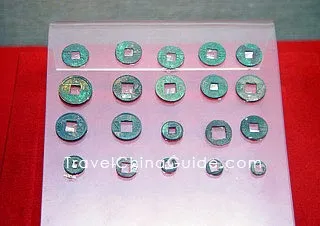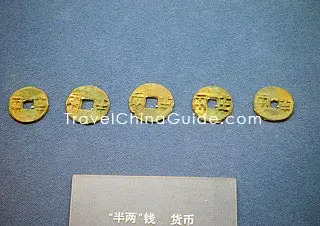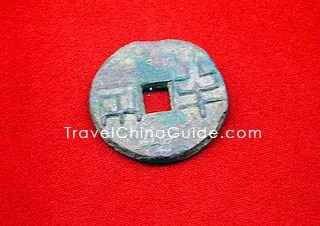Qin & Han Money - Ban Liang Qian & Wu Zhu Qian
Ban Liang Qian of Qin and Early Western Han Dynasty
As the time went on to the exciting Qin Dynasty (221 - 207BC), which left so many legacies to the Chinese people such as the Great Wall and the Terra Cotta Army, Emperor Qin Shi Huang unified the currencies circulated and laid the pattern of the Chinese coins in the subsequential dynasties. The two legal currencies were gold and bronze coin. The bronze coin originated from those used by the Qin State in previous dynasties and was named Ban Liang Qian (half liang money). Liang was a unit for weight and the coin weighed half liang. The mintage technique of Ban Liang coin did not surpass those of the Warring States but the greatness of this system was that it forbade private mintage and centralized the mintage right to the state.
Ban Liang coin can be said to have reached the foremost ideal of symmetry and balance. The round coin with a square hole in the center reflected the concept the round sky covering the square earth held by our ancestors. Round and square are representative of flexibility and strength respectively as well as mobility and stability. The round symbolizes heavenly commandment while the square symbolizes the authority of the emperor. Wherever the Ban Liang coins went, the prowess of the emperor would go.
Ban Liang coins were material economical than any other coins circulated at the time and the square hole was easy to make. This revealed that people at that time were efficiency-conscious, which was also reflected in the spectacle of the Terra Cotta Army.
The Chinese characters Ban Liang were written by Minister Li Si, the originator of zhuan shu (seal character), a font of Chinese calligraphy.
The value of Ban Liang was high compared to the low price for other goods. An interesting anecdote may help us to understand this. When Liu Bang stationed his army in Xianyang, most of officials gave him 3 Ban Liang coins while Xiao He, a well known general, gave him 5 coins. One year later, when Liu Bang became Emperor Gao Zu of Han Dynasty (206BC - 220AD), he regarded Xiao He's exploit as the most brilliant and endowed him most generously. Some people hold that besides Xiao He's achievement, these two extra coins were also a decisive factor.
In summery, the unification of currency promoted the exchange of commodities and economic development.
Two monetary records are notable during the Han Dynasty.
Monetary debit and credit had already existed during the Qin and Han Dynasties. Shi Ji recorded a case of what we call "risk investment". The background was the Rebellion of the Seven Kingdoms. To subdue the rebellion, the aristocrats in Chang'an (today's Xi'an) tried to raise fund from the bankers. The bankers did not know who would win so most of them refused this idea except one-a Mr. Wuyan. Mr. Wuyan loaned a large sum of money to the aristocrats at an interest rate of 10. After 3 months' fight, the Han aristocrats defeated the seven kingdoms and Wuyan gained a giant fortune. The world's earliest credit money was issued in 119 B.C. Made of white deer hide, this money was colorfully paint and decorated with embroidery. The deer was from the imperial park but this was not the reason why it was worth 400,000. The true reason behind was at the time, the imperial treasury was in deficit but the aristocrats plundered the people mercilessly, to turn the tables, Emperor Wu issued this kind of money to control the fortunes of the rich and to enrich the treasury. This money was not for circulation but for tribute by ministers and kings.
In 118 B.C. Wu Zhu Qian (five zhu money) coin was made upon Emperor Wu Di's reformation. Zhu was 1/24th of one liang. Some later Wu Zhu coin weighed less than its names implied but the name lasted 739 years till the mintage of Kai Yuan Tong Bao in 621 in the Tang Dynasty.
 |
| Wu Zhu Coins and Ban Liang Coins |
Ban Liang coins were material economical than any other coins circulated at the time and the square hole was easy to make. This revealed that people at that time were efficiency-conscious, which was also reflected in the spectacle of the Terra Cotta Army.
 |
| Ban Liang Coins of Qin State |
The value of Ban Liang was high compared to the low price for other goods. An interesting anecdote may help us to understand this. When Liu Bang stationed his army in Xianyang, most of officials gave him 3 Ban Liang coins while Xiao He, a well known general, gave him 5 coins. One year later, when Liu Bang became Emperor Gao Zu of Han Dynasty (206BC - 220AD), he regarded Xiao He's exploit as the most brilliant and endowed him most generously. Some people hold that besides Xiao He's achievement, these two extra coins were also a decisive factor.
In summery, the unification of currency promoted the exchange of commodities and economic development.
Two monetary records are notable during the Han Dynasty.
 |
| Ban Liang Coin, Han Dynasty |
Wu Zhu Qian
- Last updated on Aug. 07, 2025 by Gabby Li -